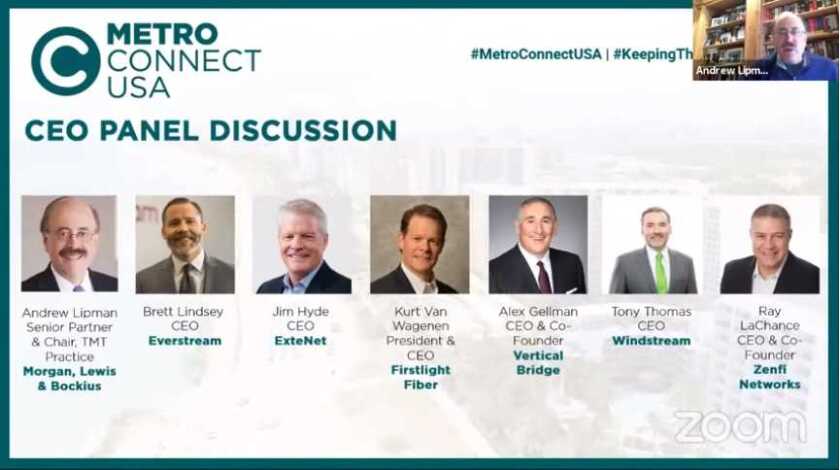Taking place on day two of the virtual show, the flagship session featured Jim Hyde, president and CEO, ExteNet Systems; Andrew Lipman, senior partner and chair, TMT practice at Morgan, Lewis & Bockius; Ray LaChance, co-founder and CEO Zenfi Networks; Kurt Van Wagenen, president and CEO FirstLight Fiber; Brett Lindsey, president and CEO, Everstream; Tony Thomas, president and CEO Windstream Holdings II, LLC; and Alex Gellman, CEO, Vertical Bridge
Spectrum costs in the US were a recurring theme, with the price tag raising concerns several times. The country's C-band auction this month raised US$80.9 billion for the FCC before carriers even start to build out infrastructure.
Thomas said: "Even on a fairly attractive interest rate, with AT&T fairly weathered to begin with it is going to be disruptive through the entire mobility supply chain."
Joining the conversation, Lipman calculated this current costs could double, because "We're also talking about another $90 billion to $100 billion for broadband funding, that's a huge dynamic as well."
Lindsay explained how the high upfront costs are likely to reroute investments from elsewhere, particularly fibre builds.
He said: "Whether it's spending billions of dollars on spectrum or focusing on other areas of their business, every year each of these guys comes out and starts talking about how fibre is sexy again and they're going to go out and build fibre.
"Except fibre building is hard and expensive and if you have to spend a ton of money on spectrum something is going to have to go by the wayside and what we tend to see every year is that building fibre goes by the wayside."
He added: "For us that has been an opportunity to do more last mile construction for wholesale than ever before."
Later in the conversation, Gellman was asked if he expected to see major carrier capex picking up in 2021. He said not; in fact, he expects 2021 to be "akin to 2020, maybe worse".
"We have a system here where we auction the spectrum and we are sucking $90 billion out of the major carriers and I don’t understand why so many people think that won't have an impact on them, when it certainly will," he said, adding that it all depends what happens next with interest rates.
"Combine that with potentially rising interest rates, and that will further affect the carrier's ability to have free cash flow to invest in their network. It takes time to deploy the spectrum it has to be clear. This year won't be the robust year some are predicting.
"Verizon and AT&T are big companies, they make a plan and then they go through it in detail for a long time. That's exactly what is going to happen with this spectrum. Plus only 100MHz of the 280 will be available this year, the rest is the end of 2023. So unless they pay more to bring that forward it will be measured over time not all at once."
He continued: "A lot say they are going to deploy the antennas ahead of the spectrum but have you ever seen anybody do that?"
M&A ahead
Concluding the hour-long session, the conversation turned to consolidation across the industry as a whole, as well as the sectors represented on the panel. s
Reflecting on Windstream's M&A strategy, Thomas said any deals this year would be "solely opportunistic".
However, on the wider view he elaborated: "I do expect the M&A trends to continue. SPACs have unprecedented levels of capital raising taking place now, look at the Liberty deal last week, we have infrastructure funds, private equity and now you put SPACs into it and you look at the interest rates overall, that's a recipe for M&A."
Meanwhile, for Zenfi Networks LaChance said the opportunity lies in driving edge colocation operations.
He said: "It's like owning the space under the tower, we are looking to own the building that we put the edge colocations in.
"It's not traditional M&A but we are in this acquisition mode where we are looking for real estate to solve that problem then we have to start thinking about geographic expansion that could bring us to acquire companies in neighbouring markets, but that hasn't been the focus yet."
Hyde expects 5G upgrades for indoor networks will drive capital as "there's always a focus to be opportunistic". He said: "It's all about value, availability of capital and timing."
Hyde continued: "There are lots of ways to spend our money; we have a nice influx of capital from our new investor and a great portfolio company approach with Colony Capital to focus on those partnerships."
Across the Digital Colony portfolio Gellman said more than 250 transactions have been completed, and he believes interest rates are likely to have the greatest influence on investment flows moving forward.
Gellman explained: "The US market is the most stable for communications infrastructure. So long as interest rates are low, people need a place to put their money and this growing awareness of the beauty of all aspects of communications infrastructure and the stability of it – and if nothing else Covid has shown the stability of these markets and how well they have performed – has led to tremendous multiple expansions in M&A."
Rounding off the conversation, Lindsey said that when it comes to very large acquisitions, the next year is likely to be the biggest of the last five.
He said: "We’re going to see multiple acquisitions that have Bs in front of them and I think it probably will be one of the biggest years of the last five for very large acquisitions to happen.
"You have a lot of folks who have been with their current investment groups for four or five years, they will be exhausting the concentration for those equity partners and you are going to see new folks wanting to come into the space," he added.





